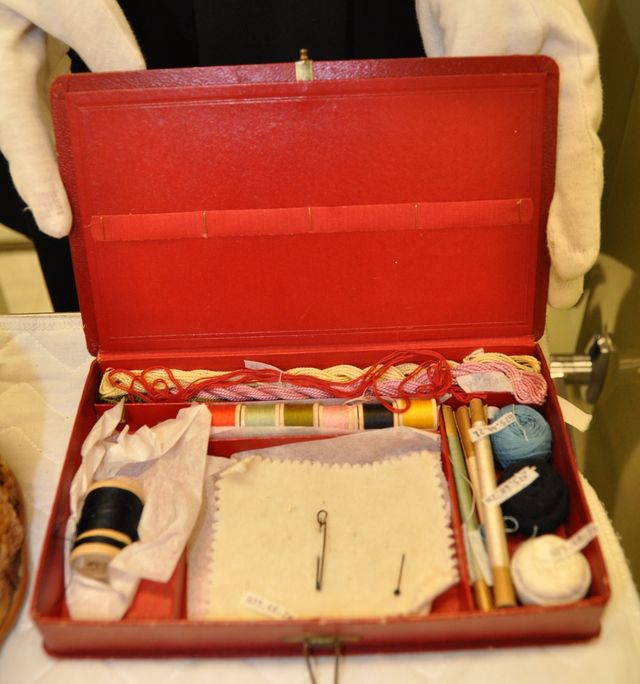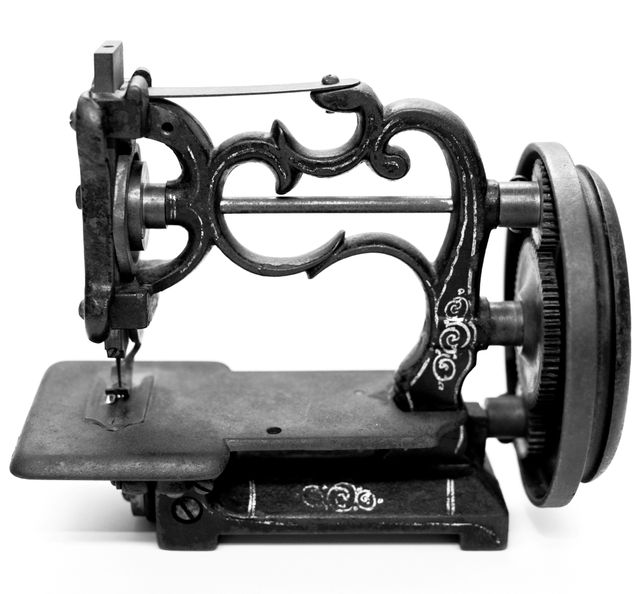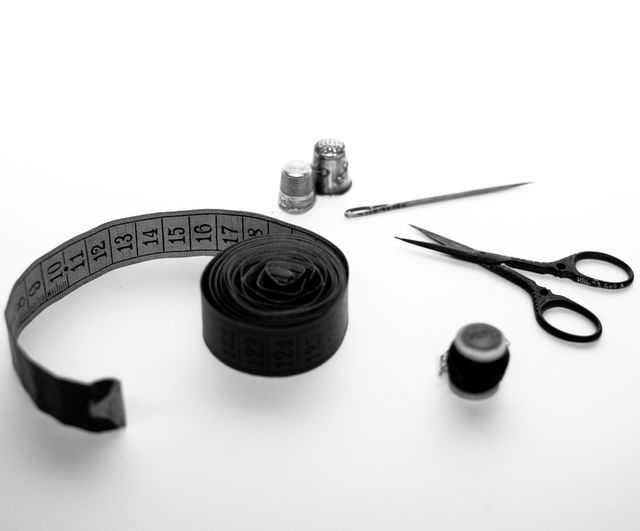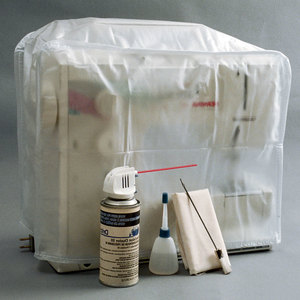
This New England Style Patented Sewing machine (circa 1870s-1880s) is a hand-cranked sewing machine with gear wheel. The most notable thing about this machine type that it has a walking presser foot to move the fabric from above, instead of feed dogs below the fabric. This sewing machine is in The Royal Alberta Museum's collection, and currently on loan to the University of Alberta.
Here at Threads, readers frequently tell us that they are fascinated with the details achieved on vintage garments.
A new exhibit at the University of Alberta in Edmonton, Canada, opens up “Grandma’s” sewing box, revealing notions that were once common, but seem almost incomprehensible now. It’s amazing to imagine women creating the details we love to see on Threads’ back cover without the technology and tools we use to sew today.
There are about 50 items in the exhibit, gathered from the University of Alberta’s collection, private collections and on loan from the Royal Alberta Museum. Some are from as far back as the 18th century. I’ll never take an electrically heated tool for granted again! How frustrating it must have been to heat an “sadiron” again and again to press a garment. I won’t swear under my breath the next time my iron spits.
In a short video on the university’s website, “Tools of an Enduring Craft,” a student demonstrates the technique for using a “fluting” or “crimping” iron to create pleats in fabric. An metal bar had to be heated and placed under the saw-toothed crimping base. A roller with matching teeth was run over fabric and the heated crimping iron base, conforming the fabric into “V’s.” The video also reveals what the results might have been on a garment – a vintage opera cape’s hem.
Another fascinating aspect of the exhibit is just how early young girls had to learn to sew, and the quality of the work that was expected of them. Some of the antique sewing machines in the exhibit are child-sized. These sewing machines, on loan from the Royal Alberta Museum, were used by girls as young as 4 or 5.
“It was important for a woman to be ready for her adult life, to sew and take care of her family. And the earlier they started to learn, the better their skills were by the time they were ready to get married,” Vlada Blinova, a course lecturer and the manager of the University’s Clothing and Textiles collection, said in a press release about the exhibit. The oldest artifact in “Tools of the Trade” is a a sampler completed by an 11-year-old girl in 1736.
“Tools of the Trade” opened May 10 and is on display through January 2012.
To see the video “Tools of an Enduring Craft” about a vintage tool to pleat fabric, click here.






































This is my GREAT, GREAT Grandmother's machine. I have my grandmother's Singer. A model 66, circa 1948, her son's bought it for her upon their return from WWII, and it replaced a much older machine in her little wooden standard Singer treadle base - I thought it was much older (given it's non-electric nature), but when it was passed on to me recently, I was astounded to find the original sales slip (showing the trade in of an older model) and the date! I remember her using it many times. I replaced the belt, did a bit of cleaning and she still works like a dream, in spite of a lot of wear and tear. Grandma Birdie Lee Fillette raised 8 chilcren in Alexandria, Louisiana.
- Karen Alexander, Austin, Tx
My first sewing machine (given to me for my 14th birthday) was a Jones 'treadle machine' with an electric motor and foot control. It had only one presser foot available and no zigzag stitch. I used this machine to make all my own clothes for the next 10 years. I worked out a way of inserting a zip and although I couldnt do a standard buttonhole with the machine I became quite good at bound buttonholes. I then bought myself a brand new Frister and Rossman machine which did everything. I thought I was in heaven. That was bought in 1971 and is still working well, although now used by my eldest daughter.
I now have a hand operated machine, very similar to the old treadle machines, to show my dressmaking students as well as 2 Singer machines that are immediately post-war models with attachments for zigzag stitch, etc, that look as though they have come from a torture chamber! I also have a lovely Brother machine that has everything I need, as well as a Singer Sewing machine/Embroidery machine.
I actually *have* a machine just like that at home! My brother gave it to me for Christmas one year - best Christmas present ever. He got it at an auction. The date on it is 1868. No, I've never used it, but it is workable, according to the collector that I showed it to.
- Jane
It's good we have the luxury to choose our tools today. I switch between my old Singer treadle machine and my newer Pfaff sewing machine depending on the project. I can't imagine being without my electric steam iron!
My grandmother inherited a similar but older machine from her mother in law in 1930's. The machine worked like a dream, however had no zigzack, no stitching back, no thread cutter etc available. Just simple straight stitching! Since it is not electrical, it can go as quickly as you can turn the "manivelle". My grandmother sew wonders on this machine for years and never wanted to replace it. I had the big pleasure of sewing a summer dress for my daughter on the machine last summer. I loved it instantly for its reliability and I came to appreciate its beauty. Turning the "manivelle" made me feel that this machine stitches in more manual way than my Elna and Janome sewing machines. I now understand better why my grandmother never replaced it. I felt that this machine is a bridge to all the women in my family who sew on it.
My grandmother inherited a similar but older machine from her mother in law in 1930's. The machine worked like a dream, however had no zigzack, no stitching back, no thread cutter etc available. Just simple straight stitching! Since it is not electrical, it can go as quickly as you can turn the "manivelle". My grandmother sew wonders on this machine for years and never wanted to replace it. I had the big pleasure of sewing a summer dress for my daughter on the machine last summer. I loved it instantly for its reliability and I came to appreciate its beauty. Turning the "manivelle" made me feel that this machine stitches in more manual way than my Elna and Janome sewing machines. I now understand better why my grandmother never replaced it. I felt that this machine is a bridge to all the women in my family who sew on it.
My first experience with sewing was on an old Singer Featherweight. When my mother bought a new Singer with cams and fancy stitches I asked for my own sewing machine and got a Little Girl's Singer for Christmas. I learned to sew on a small hand cranked machine that skidded all over the table. It wasn't easy, but that didn't deter me. I made clothes for my dolls, and eventually moved on to using my mother's new Singer.
My first electric sewing machine was a Singer Featherweight that my dad bought at a flea market. I still use it and love all the attachments.
My grandmother's first sewing machine was a Singer foot treadle with wooden drawers. The machine was covered with a wooden box when not in use. She paid a nickel a week for it. She was unsure if it was ever paid off; she just kept giving the man a nickel when he came to her door each week.
This machine came with a velvet-lined wooden box with many attachments. The box "unrolled" to lay flat; the two ends of the box unfolded into triangles. Some of these are available on ebay.com if you want to see one. The machine booklet showed how to use the ruffler, tucker, binders in several sizes and hemmer feet to turn over the edge of the fabric and stitch it. These attachments are wonderful and make certain tasks quicker and easier. There was also a gathering foot which shirred the fabric for imitation smocking; and an edge-stitcher which held trims or lace in position to sew them together right on the edge.
With a sewing machine, she made many clothes, curtains, gifts and mended clothes for the family. The Singer Company published an Art Book showing all types of hand embroidery which could be done with the simple type of sewing machine available at the time. The machines had no fancy stitches and some didn't even run in reverse. But by slowly and carefully moving the fabric it was possible to use the machine as an "electric needle" which moved much faster than hand embroidery. Copies of the Singer Instructions for Art Embroidery are still available. Up until the late forties or early fifties, women who didn't have a machine with zigzag stitch or a buttonhole attachment still sewed buttonholes by hand.
We also had unusual accessories for sewing. A spool holder was like a ferris wheel made of plastic. You could turn the wheel to find the thread you wanted.
My grandmother also had a sewing table. It was a small multi-drawered piece of walnut with some inlay decoration and two side compartments to store larger items such as knitting needles. The shallow drawers were great to organize sewing items which tend to be small.
Another unusual item is a large blunt-ended brass needle with designs embossed on it. It's a surprise to see the decoration of such a tiny object. I use it to sew sweaters together with yarn.
I've recently been sewing on a Singer 66 "Red-Eye" treadle that I picked up on Craig's - machine, accessories, and table-with-cute-wooden-drawers for $50! I love how quiet it is; I can sew on it all night without waking up my husband. And I can listen to the radio while I sew too! - although the machine seems to prefer big band. ;) It's been a good lesson in basics - having to use attachments and not just spin a knob to create the same ruffles, tucks, hems, and finishes that my great-grandmother did. Also I'm getting pretty good at sewing machine mechanics! I would have never dared to crack open the cover on my mid-90's Elna but armed with old service manuals I've dug right into this sturdy old girl and tuned her up. I loved all the old notions that were stuffed in the little drawers too - the previous owner was clearly confident enough to make her own bras and girdles! With a treadle!!! I don't know that I'll go that far though.. oh my.
Don't abandon these old machines! They are indestructible and besides, prettier!
I REALLY LOVE THE OLDER MACHINES .I HAVE A SINGER TREDLE SEWING MACHINE AND ONE OF THE FIRST SINGER ELECTRIC SEWING MACHINES. I REALLY COULD USE THAT BOOK .I LOVE THREADS SO PLEASE KEEP GOING AS IT`S A REAL DEAL IN THE WORLD TODAY
Love the older machines too! I have a turn of the century Standard sewing machine with attachments. Two attachments are for ruffling and bias tape. I have box of other attachments that I haven't tried yet. Using the attachments explains a lot about style back then.
I'd love to see more of the older tools. Can anyone point me to more websites?
I have at least two Singer treadle machines in my collection. The one first purchased in Green Bay, WI has the most beautiful table, elaborately wood-carved in a nouveau style that perfectly matches my formal parlor. But my Singer 29K58 is an industrial beauty--also with walking foot and no feed dogs-- made around 1920 in Scotland especially for shoemaking. I have it up and running, but ALAS, I have a difficult time treadling and concentrating on my workpiece at the same time. Who would have thought?
I wish I had known about this exhibit; I inherited my Gran's sewing box, which my grandfather made for her. It is full of items from wooden thread spools to pins that DO rust! There is a darning loom, still in the original box, labelled "Worlds smallest darning loom" - from a time when women still darned socks. She also had a collection of carefully scavenged lace collars, to be put to use on a different garment. All kinds of interesting gadgets I shall always hold dear.